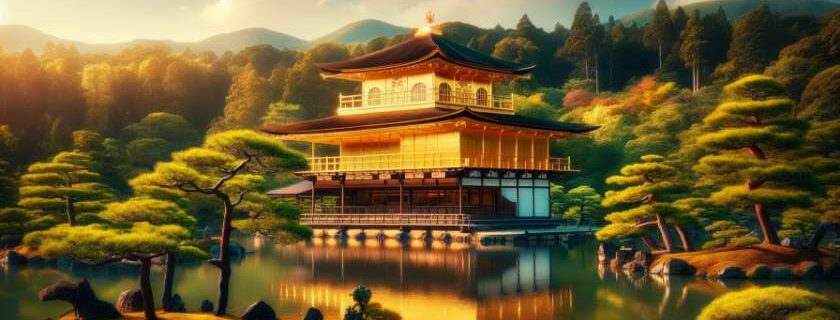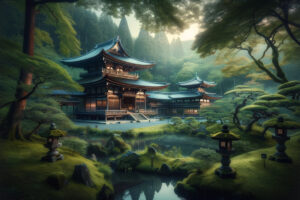
Uncover the hidden gems with our curated list of must-visit Kyoto UNESCO World Heritage sites. From ancient temples steeped in history to serene gardens exuding tranquility, each site offers a unique glimpse into Japan’s rich cultural tapestry. Get ready to immerse yourself in the beauty and heritage that define Kyoto’s allure.
Discover why these Kyoto UNESCO sites are more than just tourist attractions; they are gateways to a world where tradition meets modernity, creating an unforgettable experience for every traveler. Scroll down for reviews of our top picks and embark on a journey through time and culture in the heart of Japan.
Key Takeaways
- Explore the diversity of Kyoto’s UNESCO World Heritage Sites, including iconic landmarks like Kinkaku-ji, Ginkaku-ji, and Ryoan-ji, each offering unique cultural and historical significance.
- Immerse yourself in the beauty of Kyoto by visiting architectural marvels such as Nijo Castle, Kiyomizu-dera Temple, and Fushimi Inari Taisha Shrine, each showcasing rich Japanese heritage.
- Delve into the tranquility and spirituality of Kyoto at serene locations like Tenryu-ji Temple, Byodo-in Temple, Enryaku-ji Temple, and To-ji Temple, providing a peaceful retreat from the bustling city life.
- Capture the essence of Japanese aesthetics and design through the intricate gardens, stunning architecture, and spiritual symbolism present at these UNESCO sites in Kyoto.
- Engage with the rich history and cultural significance of each site by participating in guided tours, cultural activities, or attending traditional ceremonies to deepen your understanding and appreciation.
- Plan your visit strategically to avoid crowds and make the most of your experience at these UNESCO World Heritage Sites in Kyoto.
10 Best Kyoto UNESCO World Heritage Sites

1. Kinkaku-ji (The Golden Pavilion)
Kinkaku-ji, also known as the Golden Pavilion, is a renowned Zen Buddhist temple in Kyoto. Originally constructed as a retirement villa for a shogun in the 14th century, this iconic structure is covered in gold leaf, giving it a shimmering appearance that captivates visitors.
Surrounded by a serene pond garden, Kinkaku-ji offers picturesque views with its reflection beautifully mirrored on the water’s surface. The temple stands out not only for its stunning architecture but also for its historical significance as an important cultural property and UNESCO World Heritage Site[1].
Visitors to Kinkaku-ji can immerse themselves in the tranquility of the surroundings while marveling at the intricate details of the buildings and landscape. The harmonious blend of nature and man-made beauty makes this site one of Kyoto’s must-visit places for travelers seeking both scenic beauty and cultural enrichment.
With cherry trees adorning the landscape, especially during spring when cherry blossoms bloom, Kinkaku-ji becomes even more enchanting. This fusion of natural splendor and architectural grandeur creates an unforgettable experience that showcases Japan’s rich cultural heritage.
2. Ginkaku-ji (The Silver Pavilion)
Ginkaku-ji, also known as the Silver Pavilion, is a serene Zen temple celebrated for its refined simplicity and aesthetic charm. Although originally planned to be adorned with silver leaf like its counterpart, Kinkaku-ji (Golden Pavilion), it was left unfinished, hence earning the name “Silver” Pavilion.
This architectural gem boasts not only spiritual significance but also features a captivating dry sand garden that adds to its allure. The meticulous design of this gravel garden symbolizes flowing water through carefully raked patterns in the gravel.
Surrounded by lush greenery and maple trees that burst into vibrant hues during autumn, Ginkaku-ji offers visitors a tranquil retreat from the bustling city life of Kyoto. The temple’s architecture harmoniously blends with nature, creating a picturesque setting that embodies Japanese aesthetics and philosophy.
Visitors can stroll along the winding paths within Ginkaku-ji’s grounds while admiring the beauty of its landscape and experiencing a sense of peace and contemplation amidst historical splendor. This UNESCO World Heritage Site stands as a testament to Japan’s rich cultural heritage and architectural ingenuity.
3. Ryoan-ji (Famous for its rock garden)
Ryoan-ji’s renowned rock garden, featuring 15 carefully placed rocks amidst a sea of raked white gravel, is an iconic symbol of Zen simplicity and harmony. This unique design, devoid of any plant life, is intended to evoke a sense of tranquility and contemplation.
The garden at Ryoan-ji serves as a prime example of a karesansui or dry landscape garden, where the arrangement of rocks and gravel represents natural landscapes like mountains and rivers in miniature form. Visitors often find themselves captivated by the minimalist beauty that encourages reflection and mindfulness.
Interestingly, the specific layout of the rocks in Ryoan-ji’s garden remains a mystery to this day. Despite various interpretations over centuries, no consensus has been reached on the true meaning behind their placement. This enigmatic quality adds to the allure and mystique surrounding this UNESCO World Heritage Site.
In essence, Ryoan-ji stands out not only for its aesthetically pleasing composition but also for its profound ability to stimulate introspection and inner peace through its simple yet powerful design philosophy.
4. Nijo Castle
Nijo Castle, a historic castle complex, boasts stunning gardens and palaces that date back to the 17th century. Originally constructed as the residence for the Tokugawa shoguns, this architectural marvel is steeped in rich history.
The castle’s unique feature lies in its “nightingale floors,” designed to produce chirping sounds when stepped on. This ingenious security measure was intended to alert occupants of potential intruders, offering both protection and tranquility within the palace walls.
Visitors can immerse themselves in the intricate details of Japanese craftsmanship while exploring the various buildings within Nijo Castle. The fusion of traditional Japanese design with practical innovations makes it a must-visit destination for history enthusiasts and architecture aficionados alike.
With its captivating blend of aesthetics and functionality, Nijo Castle stands as a testament to Japan’s cultural heritage and architectural ingenuity. Stepping through its gates is like stepping back in time, providing a glimpse into Japan’s feudal past amidst serene surroundings.

5. Kiyomizu-dera Temple
Kiyomizu-dera Temple, a UNESCO World Heritage Site in ancient Kyoto, is renowned for its breathtaking panoramic views of the city. The temple’s iconic feature is its impressive wooden terrace constructed entirely without the use of nails, showcasing exceptional craftsmanship and engineering.
Visitors flock to Kiyomizu-dera not only for its architectural marvels but also for the spiritual experience it offers. The temple is home to the Otawa Waterfall, where guests can partake in a centuries-old tradition by drinking from three different streams believed to confer health, longevity, and success.
The significance of Kiyomizu-dera extends beyond its physical structures; it symbolizes Japan’s rich cultural heritage and religious practices. Every corner of this sacred site tells a story steeped in history and tradition that continues to captivate tourists and locals alike.
For those seeking an immersive journey into Japan’s past while enjoying stunning vistas of Kyoto, a visit to Kiyomizu-dera Temple promises an unforgettable experience that seamlessly blends natural beauty with architectural wonders.
6. Fushimi Inari Taisha Shrine
Fushimi Inari Taisha Shrine in Kyoto is an essential Shinto shrine devoted to Inari, the deity of rice and wealth. Its allure lies in the thousands of striking red torii gates that adorn the winding paths for hikers to explore. The vibrant hues against the lush greenery create a mesmerizing sight.
Visitors embarking on the trail through these iconic gates are treated to not just a physical journey but also a spiritual one, as they ascend towards the mountaintop where panoramic views of Kyoto await them. This experience offers a unique blend of cultural immersion and natural beauty.
The shrine’s significance extends beyond its aesthetic appeal; it symbolizes aspects deeply rooted in Japanese culture, attracting both locals and tourists seeking tranquility amidst nature’s embrace. With its historical importance and stunning surroundings, Fushimi Inari Taisha Shrine stands out as a must-visit destination for those exploring Kyoto.
7. Tenryu-ji Temple
Tenryu-ji Temple, a Zen temple founded in the 14th century by Emperor Go-Daigo, stands out for its historical significance and architectural beauty.
The temple is renowned for its breathtaking gardens meticulously designed by the esteemed landscape architect Muso Soseki, offering visitors a tranquil retreat within nature’s embrace.
One of the remarkable features of Tenryu-ji Temple is its picturesque views overlooking Arashiyama’s iconic bamboo groves, providing a serene setting that evokes a sense of peace and harmony with nature.
Visitors can explore the temple grounds and immerse themselves in the rich history and spiritual ambiance that this head temple of the Rinzai Zen sect embodies. The temple complex itself is designated as one of Kyoto’s UNESCO World Heritage Sites due to its cultural importance and preservation efforts over centuries.
8. Byodo-in Temple
The Byodo-in Temple, a UNESCO World Heritage Site, boasts the iconic Phoenix Hall renowned for its architectural beauty and historical significance. Originally constructed as a countryside villa in the 11th century, this temple stands as a testament to Japan’s rich cultural heritage.
Within the temple complex lies the revered statue of Amida Buddha, attracting visitors from around the world who seek spiritual enlightenment and marvel at its intricate design. The serene ambiance of Byodo-in Temple offers visitors a glimpse into Japan’s deep-rooted traditions and religious practices.
With its roots in Esoteric Buddhism, this main temple exemplifies the fusion of artistry and spirituality that defined the Heian period in Japanese history. The Kodo (lecture hall) on-site further showcases exquisite craftsmanship and symbolic representations integral to Buddhist teachings.
9. Enryaku-ji Temple
Historic temple complex located on Mount Hiei, founded in the 8th century. The Enryaku-ji Temple played a pivotal role in shaping Japanese Buddhism during the Heian period.
The site is renowned for its association with both Zen and Pure Land Buddhism, attracting followers seeking spiritual enlightenment. Enryaku-ji offers visitors breathtaking panoramic views of Kyoto from its elevated mountain setting.
With over 1000 years of history, this UNESCO World Heritage Site stands as a symbol of Japan’s rich cultural heritage and religious traditions. It continues to be a place where visitors can immerse themselves in the tranquility and spirituality that define traditional Japanese temples.
Enryaku-ji’s architectural beauty, serene atmosphere, and historical significance make it a must-visit destination for those interested in exploring the roots of Japanese Buddhism and experiencing the peaceful ambiance of ancient temple grounds.
10. To-ji Temple
To-ji Temple boasts Japan’s tallest wooden pagoda, towering impressively at over 55 meters high. This architectural marvel is a testament to the rich history and craftsmanship of ancient Japanese builders.
The temple served as the central hub for the Shingon Buddhist sect, playing a pivotal role in spreading Buddhist teachings throughout Japan. Its historical significance adds depth to any visit, offering insights into Japan’s spiritual heritage.
Moreover, visitors can immerse themselves in local culture by exploring the vibrant flea market held on the 21st of each month within the temple grounds. This market provides a unique opportunity to experience traditional crafts, local delicacies, and a lively atmosphere that captures the essence of Kyoto.

Summary
You’ve explored the cream of the crop. From the iconic Golden Pavilion to the serene rock garden at Ryoan-ji, each site paints a vivid picture of Japan’s rich history and cultural heritage. As you wander through these ancient grounds, it’s like stepping into a time machine that whisks you away to a bygone era filled with mystery and beauty.
Now that you’ve scratched the surface of Kyoto’s UNESCO treasures, why not plan your own adventure to witness these wonders firsthand? Whether you’re a history buff, a nature lover, or simply seeking some tranquility, Kyoto’s UNESCO sites offer something for everyone. So pack your bags, grab your camera, and get ready to embark on a journey through time and tradition in one of Japan’s most enchanting cities.
Frequently Asked Questions
What are the must-visit UNESCO sites in Kyoto?
Kyoto boasts several UNESCO World Heritage Sites, including Kinkaku-ji (The Golden Pavilion), Ginkaku-ji (The Silver Pavilion), and Fushimi Inari Taisha Shrine. Each site offers a unique cultural experience that showcases Japan’s rich history and heritage.
How can I explore the rock garden at Ryoan-ji Temple?
To experience the famous rock garden at Ryoan-ji Temple, visitors can quietly contemplate the arrangement of rocks on raked gravel from a designated viewing area. The minimalist design of this Zen garden encourages reflection and tranquility amidst nature.
Is Nijo Castle worth visiting for history enthusiasts?
Absolutely! Nijo Castle is steeped in history as it was once the residence of Tokugawa shoguns. Visitors can marvel at its stunning architecture, intricate woodwork, and beautiful gardens while immersing themselves in Japan’s feudal past.
Which temple offers panoramic views of Kyoto city?
For breathtaking panoramic views of Kyoto city, head to Kiyomizu-dera Temple. Perched on a hillside overlooking the city, this iconic temple not only provides stunning vistas but also an opportunity to soak in traditional Japanese architecture and culture.
Why should I visit Byodo-in Temple among all other options?
Byodo-in Temple stands out with its Phoenix Hall – an architectural masterpiece symbolizing rebirth and peace. This serene location allows visitors to appreciate ancient artistry while reflecting on spiritual significance within a tranquil setting.




